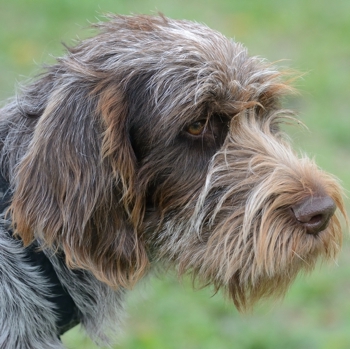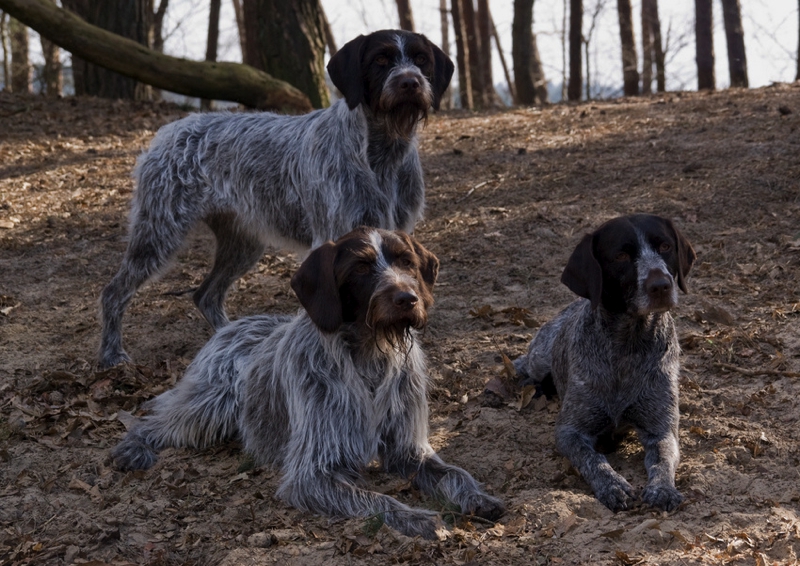Český Fousek

A medium-sized hunting dog, the Český Fousek (pronounced ‘ches-key fow-sek’) originated in the Czech Republic, where it is still commonly seen – both as a hunter and a companion animal. Its versatility is well-recognised, and this water-dog is suited to all kinds of work, whether wet or dry.
Their attractive and quirky facial fur is one of their most recognisable features, and their expressive eyes make for a striking dog. Loyal to their owner, and affectionate to most, they make a superb family pet. They have an abundance of energy and joie de vivre, and love to be outdoors and active.
About & History
The Český Fousek goes by many different names. You may know them as the Bohemian Wirehaired Pointing Griffin, the Czech Coarsehaired Pointer or the Slovakian Wirehaired Pointer.
While it is widely believed that these dogs originated in the region that is now known as the Czech Republic, their exact history is uncertain. A letter written in 1348 by a Czech nobleman mentioned a ‘Canis Bohemicus’, which may have been the modern day Český Fousek. Again, in 1724, the author Johann Friedrich Von Flemming mentioned comparable ‘roughhaired dogs from Bohemia’. While both of these references do quite likely relate to the modern day Český Fousek, it is difficult to know for sure, as the dog is not described in great detail. In 1883, however, Josef Vilém Černý wrote Huntsmanship – Handbook for Hunters and Hunting Friends, in which the Český Fousek dog is clearly defined as a Pointer.
Before the first World War it is widely accepted that the Český Fousek was the most popular wirehaired hunter in its native territory, the Czech Republic. It was also widely used in nearby countries, namely Austria and Germany. After being heavily hit in World War I (as were many other breeds of dog at the time), the Český Fousek came dangerously close to extinction. Thankfully, the Association for the Wirehaired Pointer Český Fousek was founded in 1924, with the express purpose of restoring the breed’s popularity. They had a tough job ahead of them: the breed had been decimated during the war, and German Pointers and English Pointers were becoming more popular amongst European hunters. The association powered on, and in 1931, they published their breed standard. They were determined to have only the dogs with the best hunting abilities included in the line, and they even gave potential breeding animals hunting tests to ensure they met the high standards.
Unsurprisingly, World War II also had a negative impact on the breed’s numbers, but the association worked hard to keep the breed alive, allowing other hunting dogs, such as the German Shorthaired Pointer to contribute to the breeding programme for a time. Eventually, in 1964, the Český Fousek became a recognised breed in their own right. The following year, they were so well liked within the Czech Republic that they featured on their postage stamps!
Today, this is a popular breed in both Europe and beyond. Acknowledged by the United Kennel Club in 1996, the original breeding association remains active today; and members should be deservedly proud of their successful efforts. A much-loved family pet, the Český Fousek still retains its title as a prosperous hunter, whether they are on woodland, in the field or in water.
Appearance

A medium-sized breed with a coarse coat, the Český Fousek is an athletically built dog with a wiry, muscular body. Their most noticeable trait is their distinguishing facial fur. Their soft, bushy eyebrows, moustache and beard are what make them so recognisable. Their velvety ears hang loosely to the side of their face, while their endearing almond-shaped eyes are deep-set, and can be an amber or brown colour. Their leathery nose should have large nares and must be dark brown. The top lip will hang marginally over the bottom one.
Their long back should slope downwards from the withers, and their chest is firm and deep, supported by strong and straight limbs. The tails of the working dogs are commonly docked. As they are a water dog, their toes are webbed, and they have a double coat. Their coat can be seen in a variety of colours including:
- Solid Brown
- Brown with White Markings
- Dark Roan with White Spots
- Dark Roan without White Spots
Males stand at 60-66cms, weighing 28-34kg, while females stand shorter at 58-62cms, weighing 22-28kg.
Character & Temperament
An affable and very sociable dog, the Český Fousek is just as suited to family life as they are to being a working hunter. Content to spend all day beside their master, they will willingly follow instruction after instruction, whether out working in the countryside or learning new tricks within the home. While they excel in a variety of sports, their hunting abilities are notably impressive, and they thoroughly enjoy being able to use them.
Gentle by nature, this dog just wants to be your friend and make you happy. Fantastic with children, they love having someone to play with. They can equally live contentedly alongside other animals, even cats, as long as they have done so from a young age. Their reliance on human companionship can be a double-edged sword, as they are prone to separation anxiety if left alone for long periods without ample distraction.
Trainability
The Český Fousek is a superb dog to train; quick to learn and eager to please. Naturally gifted at tracking and hunting, they need little in the way of instruction, and will instinctively take to these tasks. The breed is undeniably intelligent and responds best to consistent and interesting training.
They are hard working and possess large amounts of stamina, happy to continue working with you until the task has been completed. Versatile, they adapt well to many modern day canine activities, such as obedience and agility. Some individuals can be reserved with strangers and may bark when unsure, so early socialisation is important.
Health
This is an example of a breed that has been bred incredibly responsibly, ensuring there are only a small number of genetic conditions that they are predisposed to. They tend to live into their early teens. Conditions that are known to occur in a small number of the population and should be screened for, include:
Elbow Dysplasia
When the elbow has not formed properly, the dog’s weight is not distributed evenly, and the dog will inevitably suffer from joint pain, osteoarthritis and mobility issues.
Hip Dysplasia
Failure of the hip joints to form as they should, which will result in osteoarthritis later in life. Medications and exercise regimes, such as hydrotherapy, can help with an affected dog’s quality of life.
Osteochondrosis Dissecans
Symptoms will typically occur in the first year of life. Flaps of cartilage will break off within developing joints resulting in localised inflammation and arthritis. Surgery may be recommended in some cases.
Alopecia
Loss of fur, which may be partial or complete. While dogs can suffer from baldness for a variety of reasons, it is hereditary alopecia that has been recognised to occur in the Český Fousek.
Entropion
When part of the eyelid grows inwards, the eyelashes will rub against the cornea causing irritation and ulceration. A surgical procedure may be needed to correct this disorder if severe.
Bloat
A dreadful condition whereby a dog’s stomach enlarges, filling with air and food, and then rotates; preventing the escape of any gas or liquid. Without veterinary intervention, this will be fatal for the dog.
Exercise and Activity Levels
If there is one thing that the Český Fousek needs, it is exercise. This tireless breed has been bred for endurance and loves nothing more than to run and work non-stop. A perfect companion for a jogger or a family that likes to hike, this dog will never be lagging behind.
Failure to exercise the Český Fousek will result in a dissatisfied dog, who will likely develop bad habits to combat their boredom. Barking, in particular, can be an issue for an under-stimulated Český Fousek. Additionally, a large garden with a high, secure fence is ideal for this breed, who love to explore and keep active.
Grooming
Low-maintenance and a light shedder, the Český Fousek only needs brushing one to two times a week. Over bathing is not advised, as this will result in their coat losing its weather-proofing.
Ears should be thoroughly dried after bathing or swimming to prevent ear infections. Paws and long fur should be checked after outdoor excursions to ensure no brambles or briars have become stuck to the fur.
Famous Český Fouseks
We are yet to be graced with the presence of a celebrity Český Fousek. Given their sparkling personalities, it shouldn’t be long now. In the meantime, you can browse #ceskyfousek photos on Instagram – we came across Dora who is particularly adorable.
Cross-Breeds
There are no popular cross-breeds that include the Český Fousek at the time of writing.

